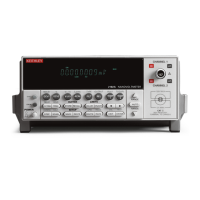Trigger model operation
Once the instrument is taken out of idle, operation proceeds through the trigger model down
to the device action. In general, the device action includes a measurement and, when stepping/
scanning, closes the next channel.
Control source — As shown in Figure 7-10, a control source is used to hold up operation
until the programmed event occurs. The control source options are as follows:
• IMMediate — Event detection is immediately satisfied allowing operation to continue.
• MANual — Event detection is satisfied by pressing the TRIG key. The Model 2182 must
be in LOCAL mode for it to respond to the TRIG key. Press the LOCAL key or send
LOCAL 7 over the bus to remove the instrument from the remote mode.
• TIMer — Event detection is immediately satisfied on the initial pass through the loop.
Each subsequent detection is satisfied when the programmed timer interval (0 to
999999.999 sec.) elapses. The timer source is only available during step/scan operation.
The timer resets to its initial state when the instrument goes into the normal mode of
operation or into the idle state.
• EXTernal — Event detection is satisfied when an input trigger via the TRIGGER LINK
connector is received by the Model 2182.
•BUS — Event detection is satisfied when a bus trigger (GET or *TRG) is received by
the Model 2182.
Delay and device action — These blocks of the trigger model operate the same for both front
panel and GPIB operation. See the front panel “Trigger model” (located at the beginning of this
section) for operating information on these trigger model blocks. Also see “Reading hold
(autosettle)” for details on Hold.
Counters — Programmable counters are used to repeat operations within the trigger model.
For example, if performing a 10-channel scan, the sample counter would be set to 10. Operation
will continue until all 10 channels are scanned and measured. If you wanted to repeat the scan
three times, you would set the trigger counter to three.
For a sample count value >1, the sample readings will automatically be stored in the buffer.
For example, with sample count set to 5, the five measured readings will be stored in the buffer.
If the trigger model is configured to repeat the sample readings (i.e. trigger count = 2), those five
new readings will overwrite the original five readings in the buffer.
Output trigger — The Model 2182 will send one or more output triggers. The output trigger
is applied to the Trigger Link connector on the rear panel. It can be used to trigger an external
instrument to perform an operation.
The trigger model can be configured to output a trigger after the completion of a series of
measurements, or after every measurement. For example, with the sample counter set to 10 and
the trigger counter set to one, a trigger will be sent after the 10 measurements are performed. If
instead, the trigger counter is set to 10 and the sample counter is set to 1, a trigger will be sent
after each measurement.
Triggering 7-15

